Pakistan has had a rough go of it of late. This map from the New York Times narrates, annotates, and illustrates just some of those problems.
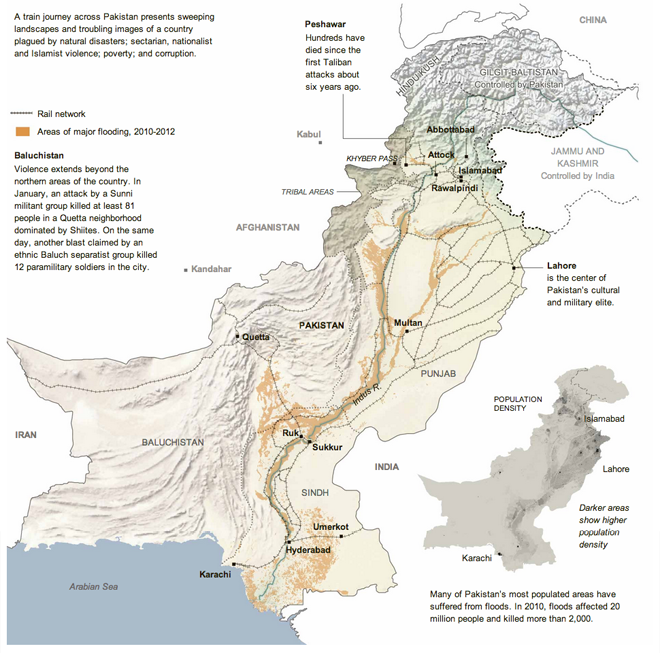
Credit for the piece goes to Timothy Wallace and Sergio Peçanha.
Pakistan has had a rough go of it of late. This map from the New York Times narrates, annotates, and illustrates just some of those problems.

Credit for the piece goes to Timothy Wallace and Sergio Peçanha.
If all is going according to plan, I should be somewhere in the Carpathian Mountains at this point, specifically in the Presov region of Slovakia. So as a reminder of just what that means, here is a (recycled) piece I created this time last year about the Carpatho-Rusyns (sometimes known as Ruthenians) living in Slovakia. Click the image to go to the full infographic.

Credit goes to me for the piece, but to the statistics office of Slovakia for the data.
It’s Friday. So what else could you want but cat videos?! On the internet?!
But seriously, that’s what I have for you today. But with a twist. The BBC and the Royal Veterinary College collaborated to document a day in the life of cats by attaching collars with micro-cameras and GPS trackers to several felines in one English village. Cats are selected by illustration at the top of the graphic. Their day’s walking path is traced out over the village while video clips of some of the more interesting parts of the day are available to watch.
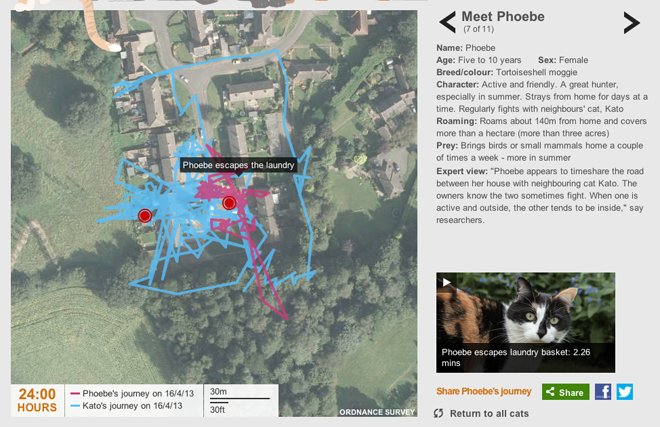
Credit for the piece goes to Steven Atherton, Chris Finch, Alex Ranken, Lucy Rodgers, Helene Sears, Marina Shchukina, and Noah Veltman.
Edward Snowden is still on the run; he is still in the transit area of Moscow’s Sheremetyevo Airport without a passport to enter Russia. But if ever succeeds in extricating himself from his current predicament, Snowden presumably will seek to land in a country without an extradition treaty with the United States.
So in this interactive piece, the Guardian explores which countries have such treaties. The list serves as an index to the actual treaty texts. Beneath the globe are samples of different texts that show how an extradition treaty is drafted. The last piece highlights three countries that are possible options, but also options that have extradition treaties in place.
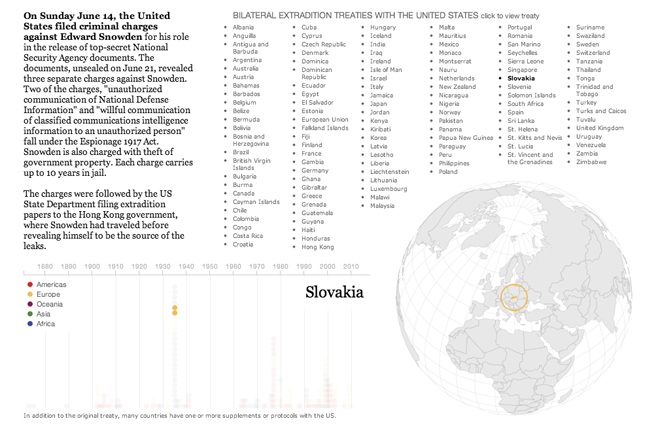
Credit for the piece goes to the Guardian US Interactive Team.
The National Post published this fascinating infographic on the Canadian fur industry. Historically speaking, that industry is one of the most important to Canada being one of the primary reasons for Canada’s colonisation by France and later the United Kingdom (to a lesser extent). The graphic provides illustrations of the pelts to scale along with data on the volume and value of the trade in each type of fur. Then it maps the ranges for each of the animals with a matrix of small multiples.
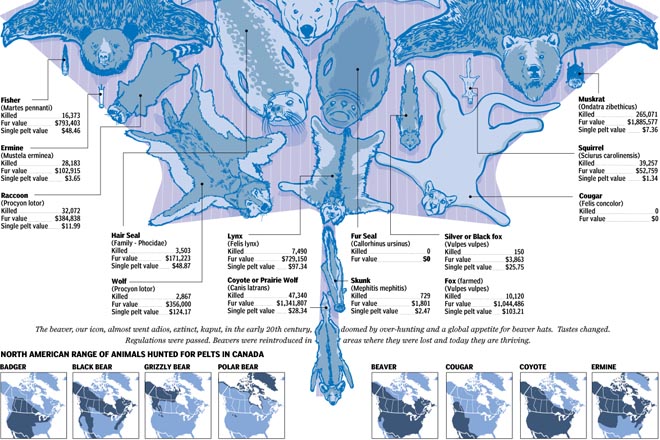
While it may not be a mistake, I am curious about the two areas of polar bears in the northern United States. Methinks that the Rockies, while snowcapped, would be a bit warm for the bears.
Credit for the piece goes to Joe O’Connor, Andrew Barr, Mike Faille, and Richard Johnson.
Last week I looked at a piece from the Washington Post about the possible impact of the Supreme Court rulings on gay marriage in the United States. But with the rulings yesterday, we step back and look at globally how the progression of gay rights has taken steps forward or backward.
The National Post looked at the reversal of bans of gay marriage as well as polling from several countries to look at changing opinions and perspectives across the world. Fascinating/horrifying are some of the stories about specific countries in the map.
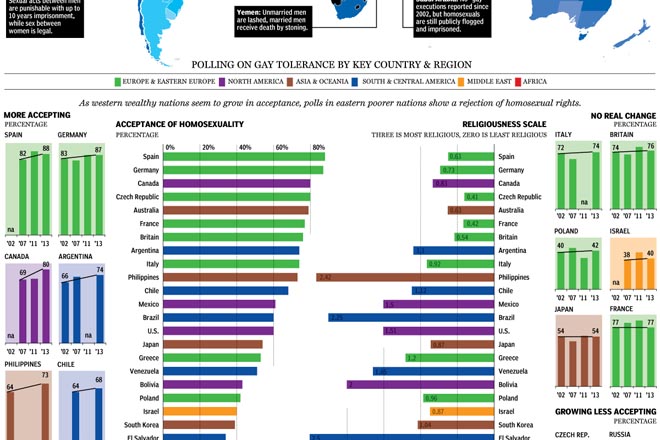
My only real criticism is that the colour-coding of regions seems a bit jarring. I wonder if grouping countries by region would not have allowed the same data to be presented in a bit quieter tone.
Credit for the piece goes to Richard Johnson.
As I have been blogging the past several days, today the Supreme Court will announce its rulings on the two gay marriage cases. But, I have already looked at that twice now. Today I want to look at the results of the Massachusetts special election for the US Senate, necessitated by John Kerry resigning from the seat to become Secretary of State.
This work comes from the Huffington Post. It offers the usual map fare with towns coloured by the victor and tinted by the share of the vote. Though do note the interesting—is this novel?—means of filling in the town with colour to represent the percent of the town reporting. My screenshot is a bit late, but check out Warren near Springfield or Boston and Cambridge—a bit harder to see because of their size and shape.
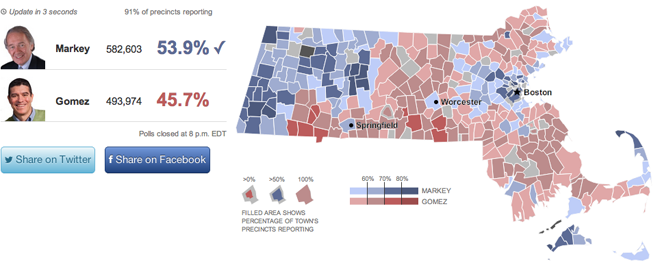
However, the fascinating thing is the use of the small multiples of scatter plots to look at historic elections. The designers included a small key in the upper-right explaining that dots above the line represent towns where Ed Markey, the Democrat who won, outperformed the historic Democrat. I have not seen anybody attempt to portray the data in this fashion before.
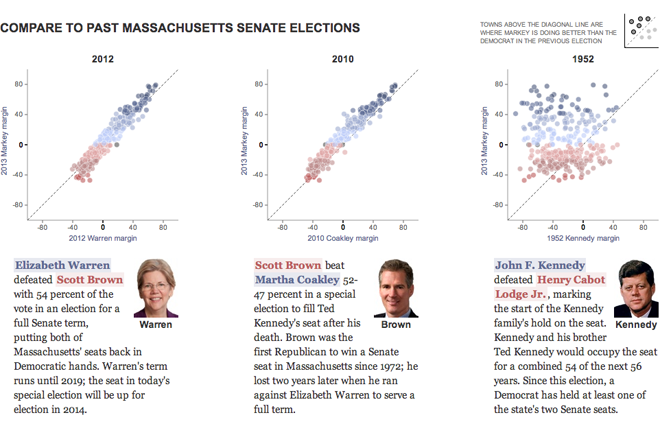
Credit for the piece goes to Aaron Bycoffe and Jay Boice.
Last Thursday we looked at the impact of potential outcomes by an expected Supreme Court ruling on two gar marriage cases. (We’re still waiting, probably until this Thursday, though it could be today.) Today, we look at the impact of potential outcomes of another big case before the Court, the Voting Rights Act. Broadly (and quickly), Shelby County, Alabama is challenging the federal government, which according to the act, must approve any changes to electoral law in those places that have had problems in their history of disenfranchising black citizens (and more recently non-English speaking citizens, i.e. Hispanics). The act was renewed for 25 years by President Bush back in 2006.
The New York Times explains through interactive maps first the geographic scope of this federal approval. As one might expect, it significantly impacts southern states. But the rules used to determine that coverage are decades old.
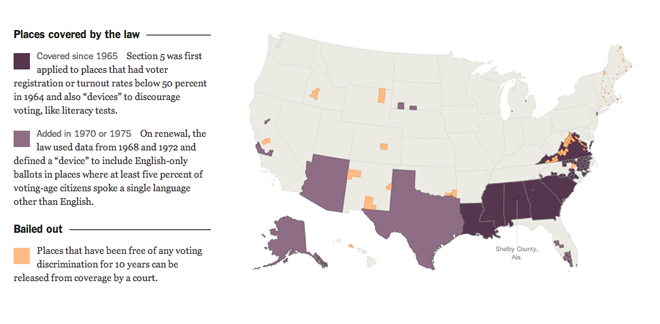
But if the current process must change, several different metrics by which alternative coverage could be determined would offer different coverage. The New York Times allows user to see those different metrics, and then adjust filters to fine tune those areas covered. A nice feature for all of these views is the ability to show/hide those areas under the current coverage.
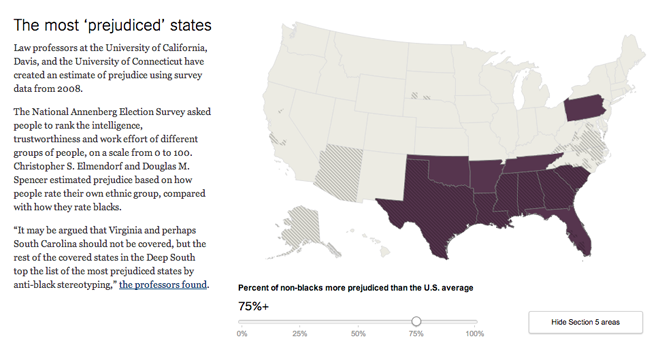
Credit for the piece goes to the New York Times graphics department.
Ever wonder what neighbourhood you really live in? In every city I have ever visited, neighbourhoods have clear cores but murky, fuzzy borders. Last year, bostongraphy.com took a stab at defining Boston’s neighbourhoods with a survey. If you read through the description and don’t just look at the pretty pictures, you will see they talk a bit about the methodology, which is quite nice. But either way, here’s a map of Boston’s neighbourhoods.
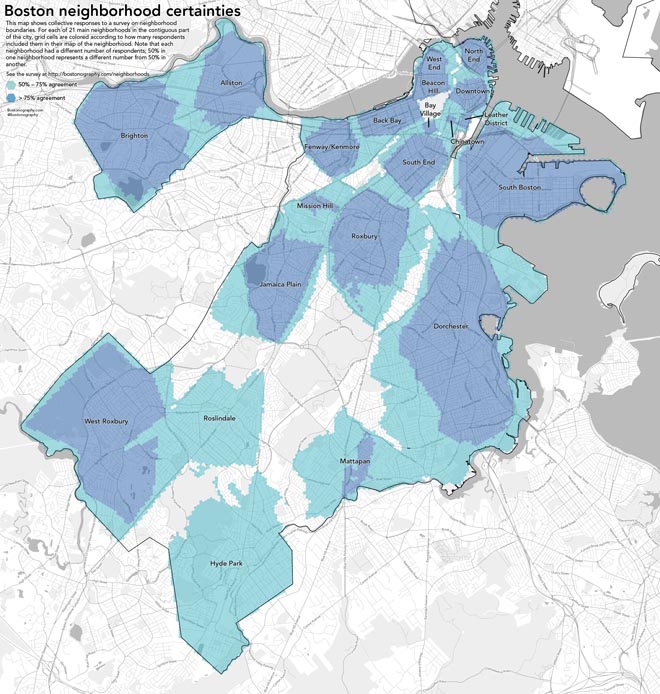
And the phrase that wins the day: “…hexagons had slightly more carto-hipster cachet.”
Credit for the piece goes to Andy Woodruff.
Rarely do I have criticism for infographics or pieces published by the New York Times, and admittedly this time I no longer have the original. However, in May, the Times published a map that was printed in black and white in their paper. I could not make heads or tails of what the map was attempting to say. I later found the online (and full-colour) version of the graphic. Because I no longer have the paper on me, I took the image and then discarded the colour information to simulate the effect.
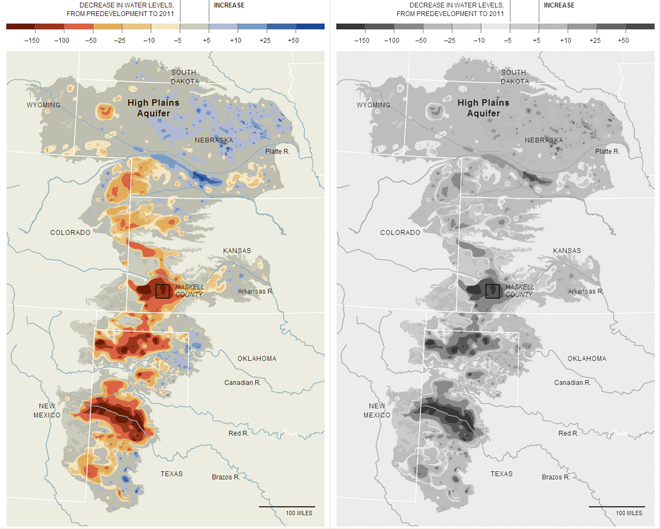
One must always beware of the ultimate use of their designed work, be it an infographic or something else entirely. If one designs for digital, online display, he or she can rest relatively assured that colour will be available for their piece. However, in a black and white print environment, the colour here in a divergent palette fails to communicate the split between increases and decreases in aquifer levels. I would have expected a different palette or the use of patterns for the print version of this story.
Credit for the piece goes to the New York Times Graphics Department